1993 BUICK CENTURY brake
[x] Cancel search: brakePage 157 of 324

In a braking skid (where the wheels are no longer
rolling), release enough pressure on the brakes to get the
wheels rolling again.
This restores steering control. Push
the brake
pedal down steadily when you have to stop
suddenly.
As long as the wheels are rolling, you will have
steering control. Steer the way you want to go.
Driving at Night
Night driving is more dangerous than day driving. One
reason is that some drivers are likely to be impaired-by
alcohol or drugs, with night vision problems, or by fatigue.
Here are some tips on night driving.
Drive defensively. Remember, this is the most
dangerous time.
Don’t drink and drive. (See “Drunken Driving” in the
Index for more on this problem.)
Adjust your inside rearview mirror to reduce the glare
from headlights behind you.
Since you can’t see as well, you may need to slow
down and keep more space between you and other
vehicles. It’s hard to tell how fast the vehicle ahead is
going just by looking at its taillights.
Slow down, especially on higher speed roads. Your
headlights can light up only
so much road ahead.
In remote areas, watch for animals.
If you’re tired, pull off the road in a safe place and rest.
ProCarManuals.com
Page 161 of 324
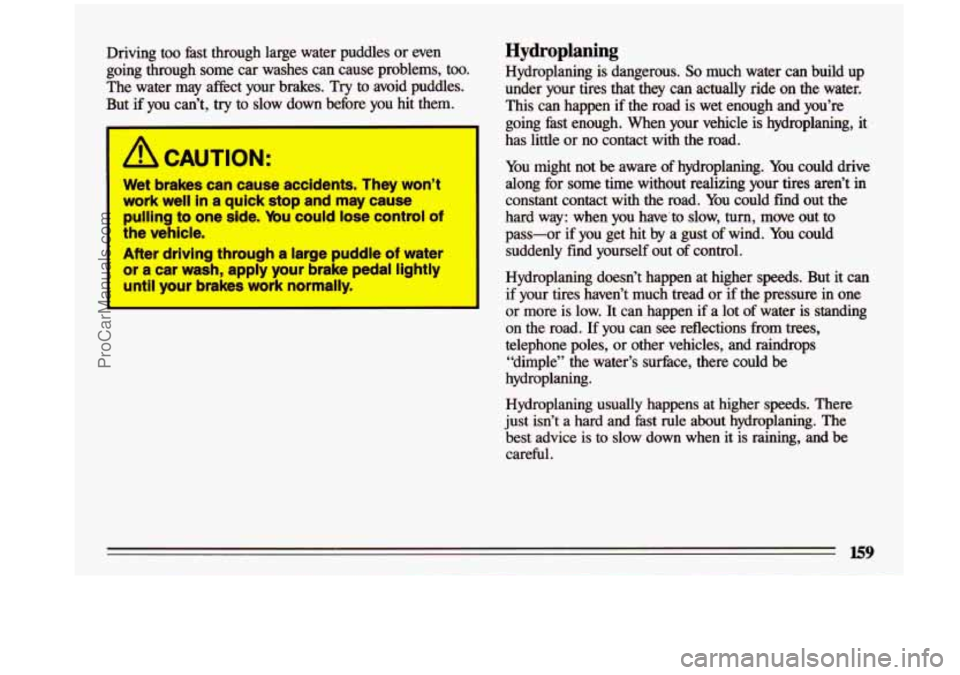
Driving too fast through large water puddles or even
going through some car washes can cause problems, too.
The water may affect your brakes. Try to avoid puddles.
But if you can’t, try to slow down before you hit them.
A CAUTION:
Wet brakes can cause accidents. They-won’t
work well in
a quick stop and may cause
pulling to one side. Ybu could lose control
of
the vehicle.
After driving through a large puddle of water
or I car wash, apply your brake pedal lightly
until your
brakes work normally.
Hydroplaning
Hydroplaning is dangerous. So much water can build up
under your tires that they can actually ride on the water.
This can happen if the road is wet enough and you’re
going fast enough. When your vehicle
is hydroplaning, it
has
little or no contact with the road.
You might not be aware of hydroplaning. You could drive
along for some time without realizing your tires aren’t in
constant contact with the road. You could
find out the
hard way: when you have’to slow, turn, move out to
pass-or if you get hit
by a gust of wind. You could
suddenly find yourself out
of control.
Hydroplaning doesn’t happen at higher
speeds. But it can
if your tires haven’t much tread or
if the pressure in one
or
more is low. It can happen if a lot of water is standing
on the road.
If you can see reflections from trees,
telephone poles, or other vehicles, and raindrops
“dimple” the water’s surface, there could be
hydroplaning.
Hydroplaning usually happens at higher speeds. There
just isn’t a hard and
fast rule about hydroplaning. The
best advice is to slow down when it is raining, and be careful.
159
ProCarManuals.com
Page 166 of 324
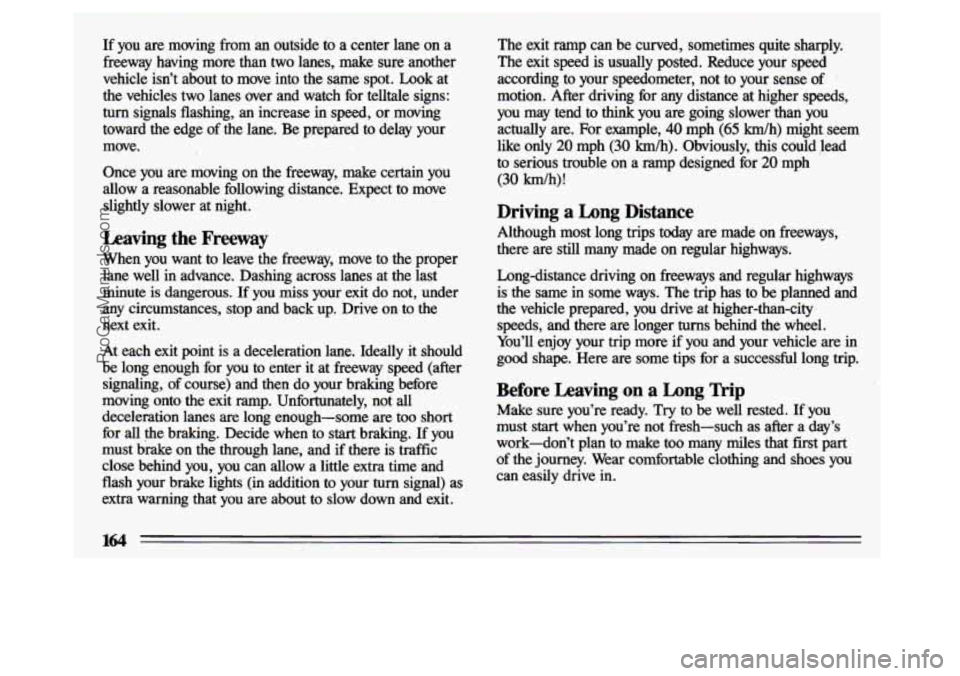
If you are moving from an outside to a center lane on a
freeway, having more than two lanes, make sure another
vehicle isn’t about
to move into the same spot. Look at
the vehicles two lanes over and watch for telltale signs:
turn signals flashing, an increase in speed, or moving
toward the edge of the lane. Be prepared to delay your
move.
Once you are moving on the freeway, make certain you
allow a reasonable following distance. Expect to move slightly slower at night.
Leaving the Freeway
When you want to-leave the freeway, move to the proper
lane well in advance. Dashing across lanes at the last
minute is dangerous.
If you miss your exit do not, under
any circumstances, stop and back up. Drive
on to the
next exit.
At each exit point is a deceleration lane. Ideally it should
be long enough for you to enter it at freeway speed (after
signaling, of course) and then do your braking before
moving onto the exit ramp. Unfortunately, not all
deceleration lanes are long enough-some are too short
for
all the braking. Decide when to start braking. If you
must bkke on the through lane, and if there is traffic
close behind you, you can allow a little extra time and
flash your brake lights (in addition to your
turn signal) as
extra warning that you are about to slow down and exit. The ,exit ramp can be curved, sometimes quite sharply.
The exit
speed is usually posted. Reduce your speed
according to your speedometer, not to your sense of
motion. After driving for any distance at higher speeds,
you may tend to
think you are going slower than you
actually
are. For example, 40 mph (65 km/h) might. seem
like only
20 mph (30 ludh). Obviously, this could lead
to serious trouble on a ramp designed for
20 mph
(30 ludh)!
Driving a Long Distance
Although most long trips today are made on freeways,
there are still many made on regular highways.
Long-distance driving on freeways and regular highways
is
the same in some ways. The trip has to be planned and
the vehicle prepared, you drive at higher-than-city
speeds, and there are longer turns behind the wheel.
You’ll enjoy your trip more if you and your vehicle are in
good shape. Here are some tips for a successful long trip.
Before Leaving on a Long Trip
Make sure you’re ready. Try to be well rested. If you
must start when you’re not fresh-such as after a day’s
work-don’t plan to make too many miles that first part
of the journey. Wear comfortable clothing and shoes you
can easily drive in.
164
ProCarManuals.com
Page 168 of 324
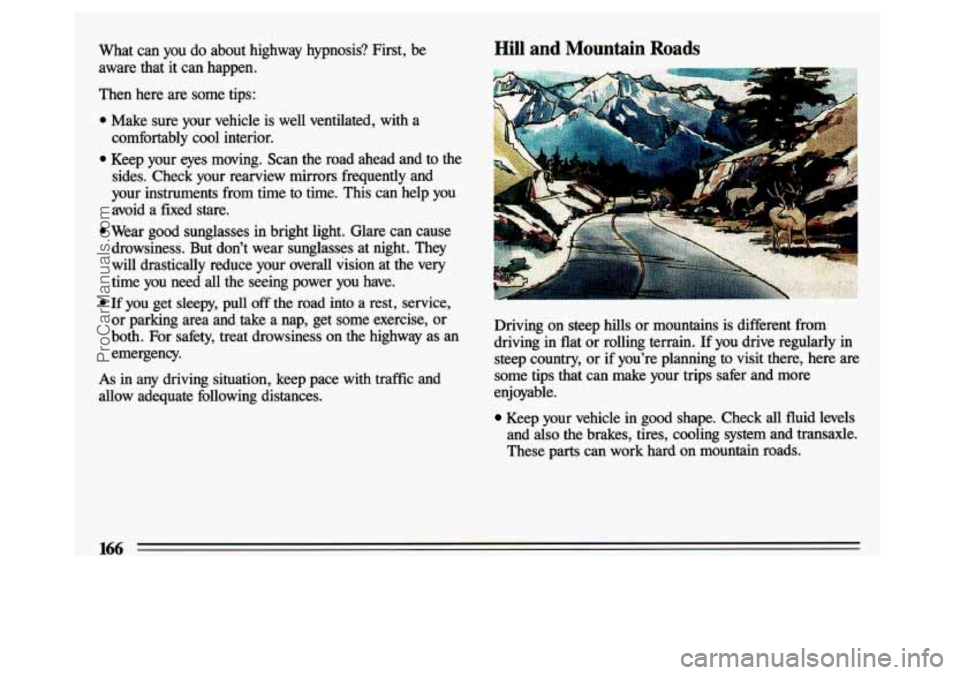
What can you do about highway hypnosis? First, be Hill and Mountain Roads
As in any driving situation, keep pace with traffic and
allow adequate following distances. Driving on steep hills
or mountains is different from
driving in flat or rolling terrain. If you drive regularly in
steep country, or if you’re planning
to visit there, here are
some tips that can make your trips safer and more
enjoyable.
Keep your vehicle in good shape. Check all fluid levels
and also the brakes, tires, cooling system and transaxle.
These parts can work hard on mountain roads.
166
ProCarManuals.com
Page 169 of 324
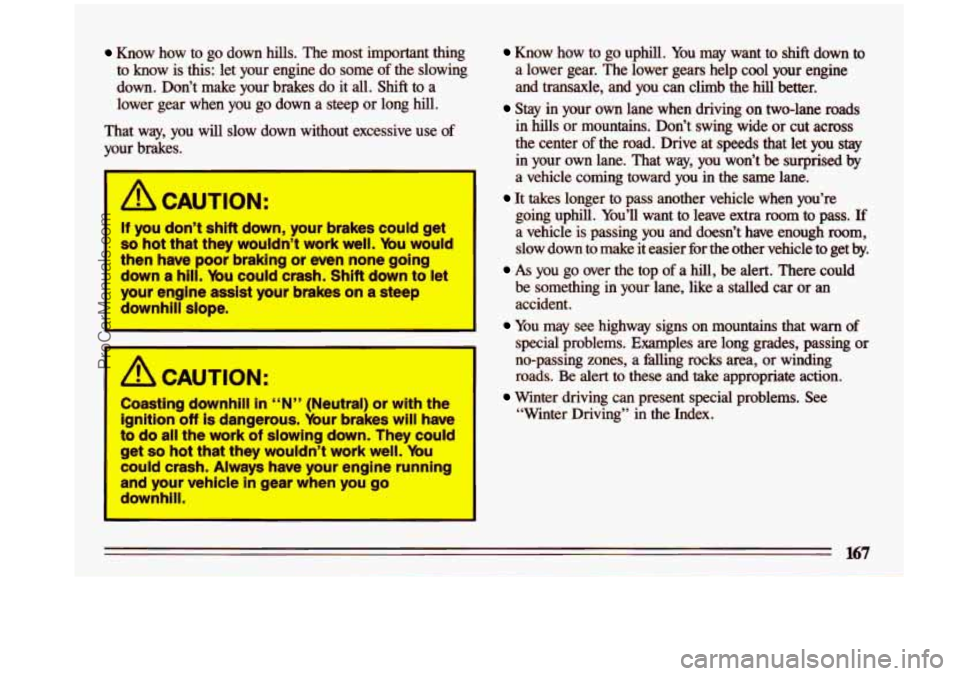
Know how to go down hills. The most important thing
to know is this: let your engine do some of the slowing
down. Don’t make your brakes do
it all. Shift to a
lower gear when you go down a steep or long hill.
That way, you will slow down without excessive use
of
your brakes.
I A CAUTION:
If you don’t shift down, your brakes could get
so hot that they wouldn’t work well. You would
then have poor braking or even none going
down
a hill. You could crash. Shift down to let
your engine assist your brakes on a steep
downhil lope.
Coasting downhill in
“N” (Neutral) or with the
ignition off is dangerous. Your brakes will have
to do
all the work of slowing down. They could
get
so hot that they wouldn’t work well. You
could crash. Always have your engine running
and your vehicle in gear when you go
downhill.
Know how to go uphill. You may want to shift down to
a lower gear. The lower gears help cool your engine
and transaxle, and you can climb the
hill better.
Stay in your own lane when driving on two-lane roads
in hills or mountains. Don’t swing wide or cut across
the center
of the road. Drive at speeds that let you stay
in your own lane. That way, you won’t be surprised by
a vehicle coming toward you in the same lane.
going uphill. You’ll want to leave extra
room to pass. If
a vehicle is passing you and doesn’t have enough room,
slow down to
make it easier for the other vehicle to get by.
be something in your lane, like a stalled car or an
accident.
It takes longer to pass another vehicle when you’re
As you go over the top of a hill, be alert. There could
You may see highway signs on mountains that warn of
special problems. Examples are long grades, passing or
no-passing zones, a Ming rocks area, or winding
roads. Be alert to these and
take appropriate action.
Winter driving can present special problems. See
“Winter Driving” in the Index.
167
ProCarManuals.com
Page 170 of 324
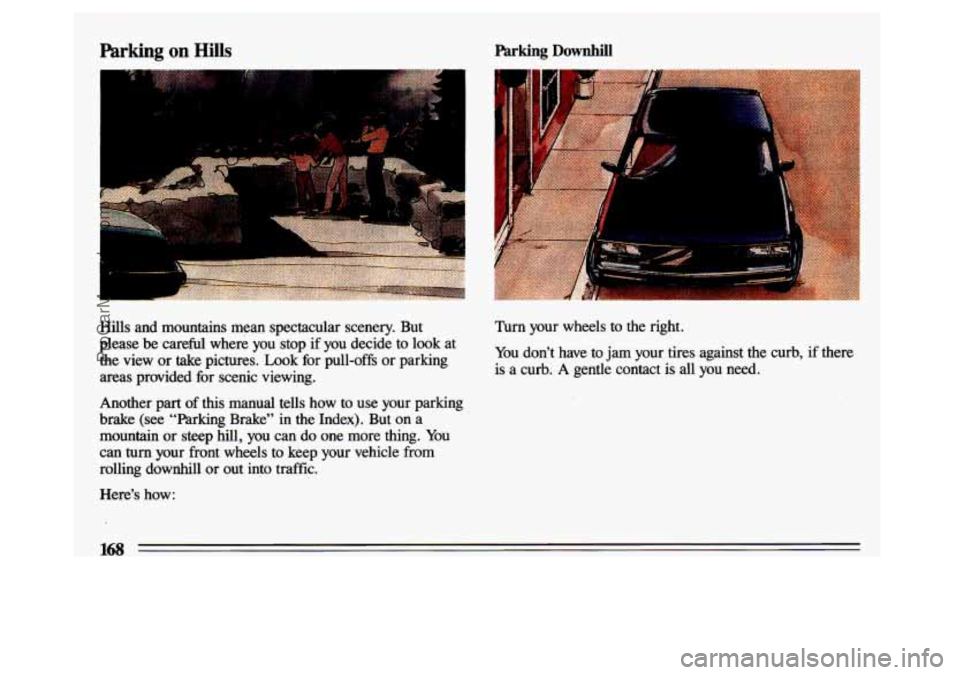
Parking on Hills
-
Parking Downhill
Hills and mountains mean spectacular scenery. But
please be careful where you stop if you decide
to look at
the view or take pictures. Look for pull-offs or parking
areas provided for scenic viewing.
Another part of
this manual tells how to use your parking
brake (see “Parking Brake” in the Index). But on a
mountain or steep hill, you can do one more thing. You
can turn your front wheels to keep your vehicle from
rolling downhill or out into traffic.
Here’s how
:
Turn your wheels to the right.
You don’t have to jam your tires against the curb,
if there
is a curb.
A gentle contact is all you need.
168
ProCarManuals.com
Page 172 of 324
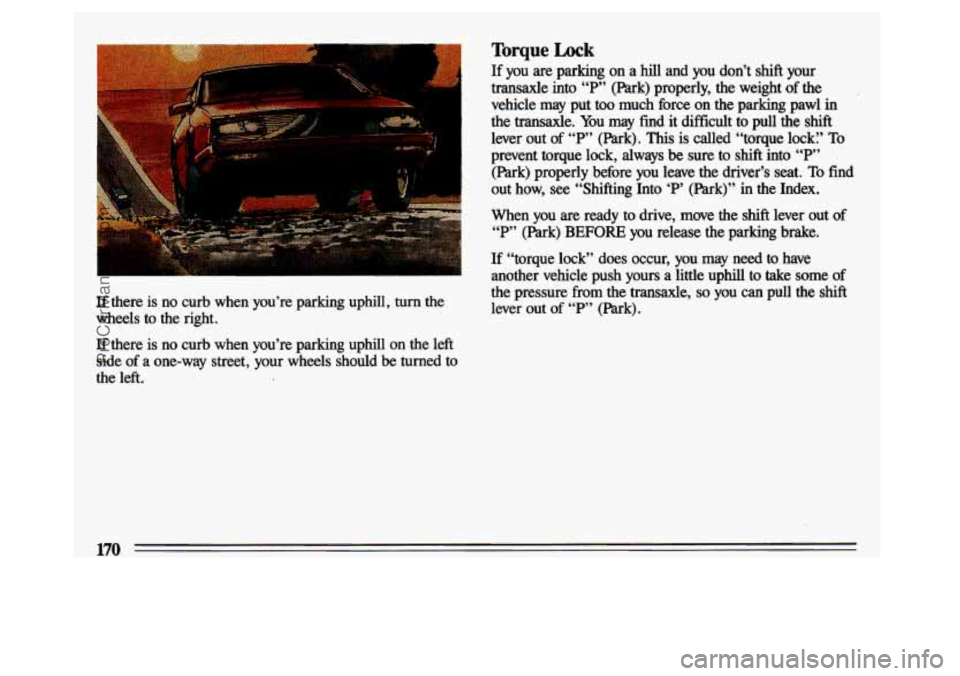
If there is no curb when you’re parking uphill, turn the
wheels to the right.
If there is no curb when you’re parking uphill on the left
side of
a one-way street, your wheels should be turned to
the left.
Torque Lock
If you are parking on a hill and you don’t shift your
transaxle into
“P” mk) properly, the weight of the
vehicle may put
too much force on the parking pawl in
the transaxle. You may find it difficult to pull the shift
lever out of “I”’ (Park). This is called “torque lock:’ To
prevent torque lock, always be sure to shift into “P”
(Park) properly before you leave the driver’s seat. To find
out how, see “Shifting Into ‘P’ (Park)” in the Index.
When you are ready
to drive, move the shift lever out of
“P” (Park) BEFORE you release the parking brake.
If “torque lock” does occur, you may need to have
another vehicle push yours a little uphill to take some of
the pressure from the transaxle,
so you can pull the shift
lever out of “P” (Park).
170
ProCarManuals.com
Page 174 of 324
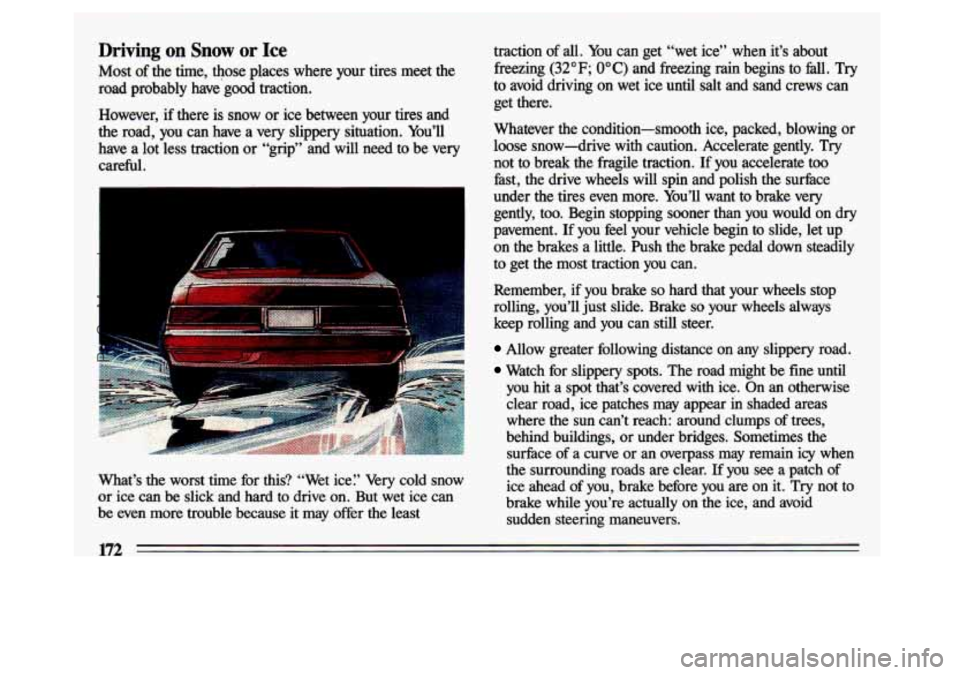
Driving on Snow or Ice
Most of the time, those places where your tires meet the
road probably have’good traction.
However, if there is
snow or ice between your tires and
the road, you can have a
very slippery situation. You’ll
have a lot less traction or “grip” and will need to be very
careful.
r
-
I
.. .
What’s the worst time for this? “Wet ice? Very cold snow
or ice can be slick and hard to drive on. But
wet ice can
be even more trouble because it may offer the least traction
of all. You can get “wet ice” when it’s about
freezing
(32°F; OOC) and freezing rain begins to fall. Try
to avoid driving on
wet ice until salt and sand crews can
get there.
Whatever the condition-smooth ice, packed, blowing or
loose snow-drive with caution. Accelerate gently. Try
not to break the fragile traction. If you acceierate too hst, the drive wheels will spin and polish the surface
under the tires even more. You’ll want to brake very
gently, too. Begin stopping sooner than you would on dry
pavement. If you feel your vehicle begin to slide, let up
on the brakes a little. fish the brake pedal down steadily
to get the most traction you can.
Remember, if you brake
so hard that your wheels stop
rolling, you’ll just slide. Brake
so your wheels always
keep rolling and you can still steer.
Allow greater following distance on any slippery road.
Watch for slippery spots. The road might be fine until
you hit a spot that’s covered with ice. On an otherwise
clear road, ice patches may appear
in shaded areas
where the sun can’t reach: around clumps of trees,
behind buildings, or under bridges. Sometimes the
surfixe of a curve or an overpass may remain icy when
the surrounding roads are clear. If you see a patch
of
ice ahead of you, brake before you are on it. Try not to
brake while you’re actually
on the ice, and avoid
sudden steering maneuvers.
ProCarManuals.com